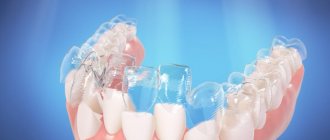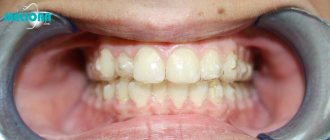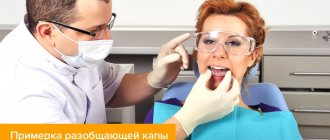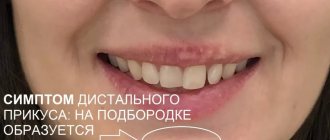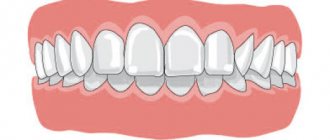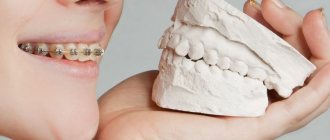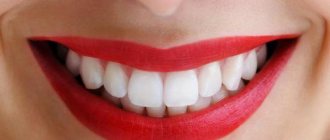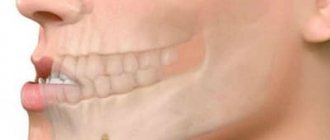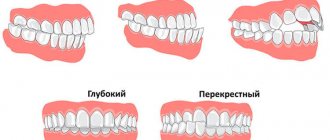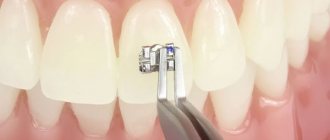Today you can create a beautiful smile not only with the help of braces, which practically do not limit the possibilities of bite correction. If it is extremely important to hide the treatment process from others, you can use Invisalign clear aligners. You just need to understand that in any case, the effectiveness and efficiency of the process will be determined not by the orthodontic system itself, but by the knowledge and skills of the dentist using it. Therefore, when choosing a correction method, you should still focus on his opinion, and not solely on your desires.
Indications for treatment with Invisalign
As noted above, Invisalign aligners cope with almost any malocclusion and are in no way inferior in effectiveness to braces. Both adults and teenagers can undergo treatment with Invisalign. Today, milk and mixed dentition are no obstacle to wearing Invisalign aligners. The technology allows you to take into account both the growth of the jaws and the change of teeth. Invisalign technology does not have an upper age limit, as with treatment with braces.
List of indications
- The technology has no restrictions in the treatment of malocclusions and tooth position. Everything depends only on a correctly drawn up treatment plan by the doctor. Enlarged gaps between the side teeth or gaps and gaps between the front incisors, or diastemas - these are all the simplest problems that Invisalign technology can handle! The same applies to crowded teeth, in which they seem to “run into” each other, pushing neighbors beyond the dentition or turning around their axis in order to fit in the jaw.
- Crowding of teeth, in which they seem to “run into” each other, pushing neighbors beyond the dentition or turning around their axis in order to fit in the jaw.
- Occlusion disorders that do not require orthognathic surgery: distal, in which the lower jaw is shifted back relative to the upper; open when the closure of the front or chewing teeth is disturbed; cross, in which the jaws shift relative to the midline of the face; straight, in which the upper and lower incisors close with the cutting edges and there is no proper overlap of the lower jaw with the upper jaw; mesial, in which the lower jaw is pushed forward relative to the upper.
Unfortunately, there are still bite problems that neither braces nor aligners can solve - in such situations, orthognathic surgery is required, preparation for which can also be done with aligners. Most often this is due to a lack of or asymmetrically developed bone structure of the facial skeleton. However, all problems of bite and tooth position that are solved with braces are also corrected with the help of Invisalign technology, and much more accurately, comfortably and completely invisible to others!
Contraindications
According to reviews, Invisalign is considered an effective way to correct almost any developmental disorder of the dentition. But still, this system also has contraindications. If the malocclusion is severe or the teeth are severely crooked, it is not advisable to use the device.
To obtain the desired effect, it is necessary to perform treatment with braces in advance. And aligners for straightening teeth should be used after this as a fixing device. Age under 12 years is considered a contraindication. According to reviews, dentists usually advise starting treatment after the age of 14, namely after the jaw is fully formed.
How is Invisalign treatment performed?
Straightening teeth and correcting bites with Invisalign has certain features and advantages. Compared to classic braces, the Invisalign mouthguard is completely invisible, does not affect diction, does not require any diet, does not complicate daily hygiene, does not injure or rub the tissues of the oral cavity. The system also does not cause such long-term painful sensations as braces, since the movement of teeth occurs in doses and in stages. Each kappa is one “step”.
Stages of teeth straightening with Invisalign
Step one.
At the initial consultation, a thorough diagnosis is carried out to make a diagnosis and plan treatment, preparatory therapy is prescribed (if required), oral sanitation and professional cleaning are carried out.
Step two.
Impressions are made of the patient’s jaws, from which the most accurate anatomical models are made. A photo protocol is being carried out. Based on the results of diagnostics and measurements in the special Clean Check program, future treatment is planned step by step and a 3D model is created. Using the program, it is possible to see the entire process of teeth movement and evaluate the future result.
Step three.
All necessary information is sent to the Align Technology laboratory, and a set of Invisalign aligners are manufactured in a certified factory located in the States.
Step four.
After receiving orthodontic aligners, the attending physician schedules an appointment at which he helps the patient put on the first pair, explains the treatment technology, issues the remaining sets of replacement aligners, gives recommendations for wearing and daily care, and sets a date for the next visit. Unlike braces, which require regular tightening on average once every three to four weeks, control visits to the orthodontist for Invisalign treatment require significantly fewer follow-up visits.
Step five.
Direct treatment with Invisalign takes about the same time as with braces: from six months to two years. You need to change your aligners about once every two weeks, and visit a doctor only once every one and a half to two months. The main rule and the key to success is to wear Invisalign aligners at least twenty hours a day, removing them only for meals and daily hygiene. The structure must be cleaned by soaking in a special solution, which is provided along with the aligners themselves, and the teeth must be brushed as usual - in the morning, in the evening before bed and after each meal.
Step six.
After completing treatment with Invisalign aligners and achieving the desired result, you will need to wear retainers for some time in order to consolidate the effect and prevent the teeth from returning to their original position.
Photos before and after Invisalign treatment
Manufacturing
Like the Invisalign braces system, aligners have their own manufacturing features. Since the method is patented by an American company, the production of aligners is carried out only in the USA. During the diagnosis, the dentist collects detailed information. To do this, an X-ray examination is performed, impressions and photographs of the teeth are taken.
After this, the collected material is sent to the USA. All information, including a scanned copy of the impression, is entered into a special program that creates several treatment options and provides them in the form of videos indicating the intermediate and final results. All options are shown to the patient. He chooses one, and based on it, a set of mouth guards is created using laser equipment for the entire duration of treatment. Typically this set includes 30 pieces. After production, the kit is sent to the customer.
Invisalign aligners and their analogues
Align Technology was the first to develop and patent this system, but nowadays teeth straightening trays are produced by many companies and are even sold in regular pharmacies. But this does not mean that they are all equally effective. We have compiled for you a comparison table of the main aligner manufacturers so that you have a correct idea of the benefits of each system.
| Manufacturer's brand | About company | Preparation method | Treatment effectiveness | Price |
Invisalign | Align Technology is the world's first technology developer and manufacturer of aligners. The company has a scientific and clinical base and a research laboratory. | Factory manufactured using patented SmartTrack material for a more comfortable and effective treatment experience. All products undergo strict quality control. | The only manufacturer on the market that provides evidence of the effectiveness of aligners in the form of case histories and completed treatment cases. | from 169,000 rub. |
OrthoSnap | The company appeared about 10 years ago in the United States as a manufacturer of a cheaper analogue of Invisalign aligners. | It produces mouthguards in its own research laboratory from hypoallergenic polycarbonates. The company does not use 3D models. | The product is positioned as a product capable of correcting any malocclusion. | from 100,000 rub. |
Star Smile | Russian manufacturer of aligners. The company does not have its own developments and research; it uses technologies borrowed from leading manufacturers | Star Smile mouthguards are made in the laboratory from conventional polymer materials supplied from Germany. | Openly declares the presence of limitations in treatment - the company’s website lists specific cases that can be corrected with these mouthguards. | from 80,000 rub. |
Air Align | An ambitious company that has offices in many European countries. It has its own scientific and clinical base. | Aligners are made from standard hypoallergenic plastic. | The company does not indicate which malocclusions are eligible for treatment using the Air Align system, stating that these aligners can completely replace braces. | from 150,000 rub. |
3D Smile | Has been on the market for less than 6 years. Has its own laboratory in Moscow. It does not have its own technologies or research. | For the manufacture of mouth guards, transparent polymer materials are used. | The manufacturer claims that the product is able to correct any type of malocclusion and all dental anomalies better than braces. | from 120,000 rub. |
Make an appointment
right now!
Vilnevchits Nadezhda Vladimirovna
Orthodontist
Price
Since the system is considered an innovative technique that corrects bite problems using individually developed treatment, its price is noticeably different from similar methods of teeth straightening.
But even in one clinic there is a noticeable difference in prices. This is due to the fact that the cost is influenced by the following factors:
- The complexity of the aligner design, which is determined by the severity of the anomaly and the characteristics of the formation of the dentition.
- Number of kappa Corrections may require plates to be placed on both jaws. In this case, the price increases by 2 times.
- Treatment time. If a long-term and gentle option is chosen, then more aligners will be required, which increases the price. To save money, you can choose a set with a minimum number of aligners. In this case, it must be taken into account that the treatment will be painful.
Depending on the chosen method, the average price is 230-350 thousand rubles. Although these designs allow you to correct your bite, treatment will only be effective if you follow all the doctor’s recommendations.
Braces and Invisalign - which is better?
Braces and Invisalign work equally well. It is a mistake to believe that mouthguards will be less effective than traditional braces. If you decide to see an orthodontist and can't decide between Invisalign and braces, schedule a consultation with several specialists. However, it must be taken into account that every doctor prefers to work with the system that is familiar to him. For this reason, even a competent orthodontist who does not work with aligners, but successfully treats with classic braces, may decide that orthodontic aligners are not suitable for you.
After installation
Within a few hours after installation, the structure is perceived as a foreign body. There is an increase in salivation, and some pressure is felt on the teeth. The adaptation time depends on the quality of the material and the hardness of the aligners.
The degree of pressure depends on the difference between the bite and the aligners. During the first couple of hours, it is advisable not to eat or drink, since it will be difficult for the body: food will come in, but there is an object in the mouth that cannot be swallowed. When the strong secretion of saliva disappears, you can eat and drink, usually this happens after 1-2 hours.
What to choose - Star Smile or Invisalign?
Demand creates supply, and competition is the engine of progress. In this regard, in recent decades, more and more new analogues of the first elastic mouth guards for correcting malocclusion have entered the market. So, in addition to the proven Invisalign aligners, you can find many other brands, both foreign and domestic. Some of them honestly, like the Star Smile company, admit that the number of cases that can be treated on their system is limited. Some, like OrthoSnap, claim that their products are in no way inferior to Invisalign, but they do not use 3D modeling in the production of their aligners, which casts doubt on such slogans. Also gaining popularity among manufacturers of orthodontic aligners are Air Align, whose price tag is approaching that of Invisalign, and 3D Smile.
However, only Invisalign's patented aligners are manufactured in a specialized factory from SmartTrack, a hypoallergenic, elastic material that provides maximum comfort and treatment effectiveness. And only Align Technology has been investing in fundamental developments for decades, maintaining a scientific and clinical base of strict reporting and maintaining a research laboratory. The Invisalign company has consultants (orthodontic professors) on its staff and was among the first to pay close attention to functional diseases of the temporomandibular joint - the so-called TMJ dysfunctions.
The only advantage of all of the above competitors is their comparatively lower price, but only Invisalign has such a long experience and proven results in the treatment of many thousands of patients.
Innovative technology for gentle bite correction
The appointment at the clinic is led by orthodontist Armen Fedorovich Kazaryan, Clinical Director of Invisalign Russia.
Member of the Russian Society of Orthodontists since 2001. If nature has not rewarded you with a snow-white smile and even teeth that look like pearls, there is no reason to be upset. Modern technologies will give you the result you have dreamed of for so long. Instead of unaesthetic braces, dentists recommend Invisalign, an American development for correcting bite pathology, which eliminates all defects within a period of one and a half months to two years.
Stars who wore aligners
Most celebrities cannot afford to wear braces, so Invisalign aligners have become a real salvation for them.
Gisele Bündchen
The only flaw in Giselle's appearance was once a crooked front tooth, for the sake of straightening which she put on aligners.
Zac Efron
Many celebrities are proud of their gap hair, but not Zac Efron. The gaps between his front teeth gave him a rustic appearance. Thanks to wearing aligners, the actor’s appearance changed dramatically.
Khloe Kardashian
Socialite Chloe always thought she had uneven teeth and wanted to fix them, but only decided to undergo orthodontic treatment last year.
Justin Bieber
A favorite of teenage girls, sweet-voiced Justin would never agree to ruin his image and put braces on his teeth. The Invisalign system helped him achieve his perfect smile.
Eva Longoria
Desperate housewife Eva Longoria is rarely tormented by doubts. I decided to correct my crooked teeth - I chose Invisalign - and that was the end of it!
Age
Conventionally, there are 3 age groups of patients who can get rid of the problem of uneven teeth:
- Children 5-10 years old. At this age, it is sufficient to carry out therapeutic and preventive measures.
- Teenagers under 18 years of age. From the age of 14, doctors recommend using aligners. Depending on the problem, other products may be prescribed.
- Adults over 18 years old. Treatment is complicated due to age-related changes, the presence of filled teeth or their absence.
It is up to the doctor to decide whether to use mouthguards or not. Removable structures will bring results if used correctly. During the entire treatment period, you must visit a doctor.
Children and adolescents treated with Invisalign experience teeth straightening at an increased rate. The reason is that before the age of 25, bone tissue regeneration occurs faster in a person, the ossification of bone sutures has not completed, so orthodontic treatment will be more effective.
But you can help adults too. Dentists have long practiced straightening teeth for people of all ages. It just takes more time. Orthodontists usually suggest the use of braces or aligners. If only 1 or 2 teeth are incorrectly placed, doctors use veneers. These very thin overlays will help solve the problem of an imperfect smile. If the problem is in several teeth, and the doctor has identified malocclusions, then orthodontic structures are needed.
